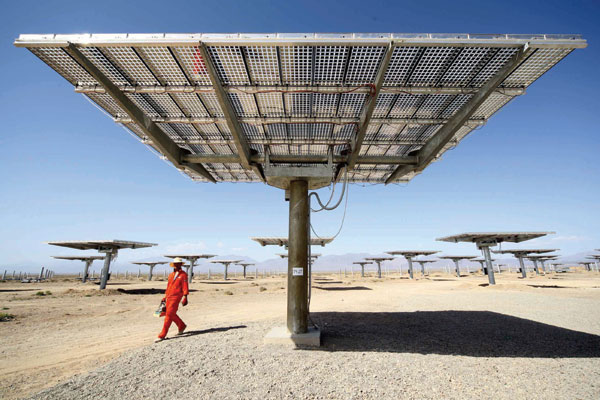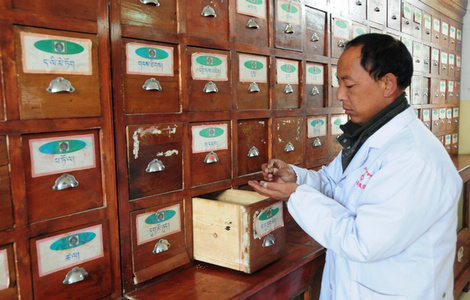
|
 A solar power industry park in Hami, Xinjiang Uygur autonomous region. Cai Zengle / For China Daily |
China's rapid transition to a green economy will be a boom both to its domestic market and the global economy, especially renewable energy industry, leading experts have said.
Commitment to developing a sustainable economy, emphasizing domestic consumption, and putting a green economy at the heart of the planning process already form the basis of China's ongoing 12th Five-Year Plan (2011-15).
"We definitely need China to succeed if the world is to succeed. Whatever China does will have global repercussions because a lot of the world's manufacturing is going on there," said Nis Hoeyrup Christensen, advisor on Chinese affairs at the Confederation of Danish Industry (CDI), and researcher in China's renewable energy sector at Copenhagen Business School.
He added that a green transition in China's manufacturing model will have especial relevance where it concerns production for the domestic market, "because that amounts to a lot of economic activity."
The UN's Environment Program defines the green economy as one where "growth in income and employment should be driven by public and private investments that reduce carbon emissions and pollution, enhance energy and resource efficiency, and prevent the loss of biodiversity and ecosystem services."
For its part, China is making a green refurbishment of its economy under a number of key headings defined in its 12th Five-Year Plan. These include that value-added output of emerging strategic industries will account for eight percent of gross domestic product (GDP), and that the country's manufacturing base in coastal regions will transit to high-end manufacturing, services and research and development.
Keystones in China's greening process include replacing coal-fired plants with those run on renewable sources like bio-mass, wind energy and solar power. Other areas involve better insulation of homes and offices to cut heating bills, combined urban heating and power networks, more recycling, improving energy-efficiency of production facilities, and developing alternative-fuel cars.
In fact, China is now the world's largest maker of wind turbines and solar panels, and its largest market for wind power. Moreover, the Chinese government says it plans to increase the share of non fossil-fuel based energy in the country's total energy consumption to 11.4 percent in 2015, up from 8.3 percent in 2010.
Green model
Denmark and its Nordic neighbors, who have been first-movers in the global green growth arena, could stand to benefit commercially from China's rapid green transition.
"I believe a more sustainable growth in China can turn out to be an advantage to Danish companies because of the technologies and solutions we have developed in our effort to create a green economy," said CEO of the CDI, Karsten Dybvad.
According to the CDI, the Danish economy has grown 78 percent since 1980, while keeping energy consumption more or less constant and slashing carbon dioxide (CO2) emissions, owing largely to technological developments in renewable energy and energy-saving.
The Danish or Nordic model of green development can be adopted in emerging economies as well, as long as they are scaled-up and adapted to fit local needs, experts say.
In fact, technology adoption and transfer would likely see Nordic technology and energy firms work even more closely with Chinese partners so as to better understand and respond to the needs of China's green market, Christensen said.
New chances
"China is at a crucial stage where the tracks will be laid out for the future direction of welfare policies and economic restructuring," Dybvad said, referring to China's move away from export-led growth and towards greater domestic consumption.
The social impact of re-balancing can perhaps be felt most palpably in the way China expects to care for its rapidly-aging population. According to Chinese official data, the country's elderly population equaled 185 million persons at the end of 2011, and is expected to be 221 million before 2015.
"Danish politicians have talked about exporting our welfare technology for a long time. This means equipment for old people's homes and hospitals, and tools which makes life easier for the elderly and for those who work with them," said Christina Boutrup, author of "China Sweet and Sour", a book on Danish companies' experiences in China.
"While this was just a dream scenario for Danish exporters in the past, China's move towards sustainability means the dream can now be realized," she added, pointing to this burgeoning area of business collaboration.
Although Danish companies can face "fierce competition from local players" when marketing welfare or energy technologies in China, Boutrup believes they hold a competitive edge as they can meet China's increasingly tighter environmental regulations, "even if they are more expensive."
Whatever the specific, future investment areas, companies will need a stable market with clear policy indicators of how best they can deploy their resources over time.
Given the Chinese government's grip on macroeconomic policy, Christensen believes these factors already exist in China and are among the stepping-stones to its green transition.
"If investors are going to put money into establishing a new technology or company, they need to be sure there is a market. In China, there is a market and a clear horizon, which the Chinese government is pretty good at showing, as it puts up both short-and-long term economic goals," he said.







